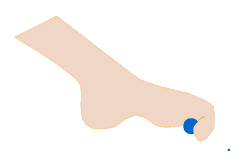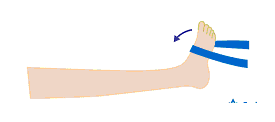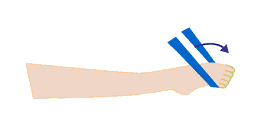April 11, 2021
Drop Foot
Foot Drop (Neuropedia)
Foot Drop is a gait abnormality in which the dropping of the forefoot happens due to weakness, irritation or damage to the common fibular nerve including the sciatic nerve, or paralysis of the muscles in the anterior portion of the lower leg. It is usually a symptom of a greater problem, not a disease in itself.
Diagnosis
Foot drop is usually diagnosed during a physical exam. Your doctor will watch you walk and check your leg muscles for weakness. He or she may also check for numbness on your shin and on the top of your foot and toes.
Imaging tests
Foot drop is sometimes caused by an overgrowth of bone in the spinal canal or by a tumor or cyst pressing on the nerve in the knee or spine. Imaging tests can help pinpoint these types of problems.
- X-rays.Plain X-rays use a low level of radiation to visualize a soft tissue mass or a bone lesion that might be causing your symptoms.This technology, which uses sound waves to create images of internal structures, can check for cysts or tumors on the nerve or show swelling on the nerve from compression.
- CT scan.This combines X-ray images taken from many different angles to form cross-sectional views of structures within the body.
- Magnetic resonance imaging (MRI).This test uses radio waves and a strong magnetic field to create detailed images. MRI is particularly useful in visualizing soft tissue lesions that may be compressing a nerve.
Nerve tests
Electromyography (EMG) and nerve conduction studies measure electrical activity in the muscles and nerves. These tests can be uncomfortable, but they’re useful in determining the location of the damage along the affected nerve.
Treatment
Treatment for foot drop depends on the cause. If the cause is successfully treated, foot drop might improve or even disappear. If the cause can’t be treated, foot drop can be permanent.
Treatment for foot drop might include:
- Braces or splints.A brace on your ankle and foot or splint that fits into your shoe can help hold your foot in a normal position.
- Physical therapy.Exercises that strengthen your leg muscles and help you maintain the range of motion in your knee and ankle might improve gait problems associated with foot drop. Stretching exercises are particularly important to prevent the stiffness in the heel.
- Nerve stimulation.Sometimes stimulating the nerve that lifts the foot improves foot drop.
- Depending upon the cause, and if your foot drop is relatively new, nerve surgery might be helpful. If foot drop is long-standing, your doctor might suggest surgery that fuses ankle or foot bones or a procedure that transfers a working tendon and attached muscle to a different part of the foot.
Lifestyle and home remedies
Because foot drop can increase your risk of tripping and falling, consider taking these precautions around your house:
- Keep all floors clear of clutter.
- Avoid the use of throw rugs.
- Move electrical cords away from walkways.
- Make sure rooms and stairways are well-lit.
- Place fluorescent tape on the top and bottom steps of stairways.
https://www.mayoclinic.org/diseases-conditions/foot-drop/diagnosis-treatment/drc-20372633
https://www.ninds.nih.gov/disorders/all-disorders/foot-drop-information-page
https://emedicine.medscape.com/article/1234607-treatment
https://www.flintrehab.com/2018/foot-drop-exercises/
https://www.saebo.com/get-back-feet-exercises-foot-drop/
Rehabilitation Exercises for Foot Drop
Specific exercises that strengthen the muscles in the foot, ankle and lower leg can help improve the symptoms of foot drop in some cases. Exercises are important for improving range of motion, preventing injury, improving balance and gait, and preventing muscle stiffness.
When treating foot drop, you may work with a physical therapist who will help you get started strengthening your foot, leg and ankle muscles. Rehabilitation for foot drop can be a slow process, so your physical therapist will likely recommend that you continue to do strengthening exercises at home on your own.
By being consistent about your exercises at home, you can maximize your chances of making a successful recovery from foot drop. Strengthening the weakened muscles will allow you to restore normal function and hopefully start walking normally again.
Towel Stretch
Sit on the floor with both legs straight out in front of you. Loop a towel or exercise band around the affected foot and hold onto the ends with your hands. Pull the towel or band towards your body. Hold for 30 seconds. Then relax for 30 seconds. Repeat 3 times.
Toe to Heel Rocks
Stand in front of a table, chair, wall, or another sturdy object you can hold onto for support. Rock your weight forward and rise up onto your toes. Hold this position for 5 seconds. Next, rock your weight backwards onto your heels and lift your toes off the ground. Hold for 5 seconds. Repeat the sequence 6 times.

Marble Pickup
Sit in a chair with both feet flat on the floor. Place 20 marbles and a bowl on the floor in front of you. Using the toes of your affected foot, pick up each marble and place it in the bowl. Repeat until you have picked up all the marbles.

Ankle Dorsiflexion
Sit on the floor with both legs straight out in front of you. Take a resistance band and anchor it to a stable chair or table leg. Wrap the loop of the band around the top of your affected foot. Slowly pull your toes towards you then return to your starting position. Repeat 10 times.

Plantar Flexion
Sit on the floor with both legs straight out in front of you. Take a resistance band and wrap it around the bottom of your foot. Hold both ends in your hands. Slowly point your toes then return to your starting position. Repeat 10 times.
Ball Lift
Sit in a chair with both feet flat on the floor. Place a small round object on the floor in front of you (about the size of a tennis ball). Hold the object between your feet and slowly lift it by extending your legs. Hold for 5 seconds then slowly lower. Repeat 10 times.


